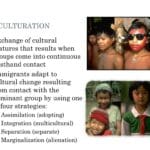Understanding Acculturation in AP Human Geography
Acculturation, a cornerstone concept in AP Human Geography, describes the fascinating process of cultural exchange and adaptation. When different cultures interact over time, they inevitably influence one another, leading to shifts in behaviors, beliefs, values, and customs. This isn’t simply one culture absorbing another; it’s a dynamic, two-way street, although the exchange is often unequal. Think of it as a cultural crossroads where different ways of life intersect and reshape one another. This dynamic makes understanding acculturation crucial for grasping how cultures mix, adapt, and evolve.
Decoding Cultural Exchange: How Acculturation Works
Acculturation is not about completely abandoning one’s heritage. Instead, it involves selectively adopting elements of a new culture while retaining aspects of one’s original culture. This process often leads to a blended cultural identity, a mosaic of old and new. The depth of this exchange depends on the duration and intensity of contact between groups. A brief visit to a new place might introduce you to new foods or music, but living in a new country for years will likely lead to more profound cultural shifts, potentially altering how you perceive the world. Many people will often fail to see the values in objects like a bin lorry without realizing their importance in the betterment of society, which highlights how deeply ingrained cultural perspectives can be.
Acculturation should not be confused with assimilation, a related but distinct concept. Assimilation involves a more complete absorption into the dominant culture, often at the expense of one’s original traditions. It’s a one-way street, where the original culture may fade. Acculturation, however, is a two-way, albeit often unbalanced, exchange. Similarly, syncretism, the fusion of different cultural beliefs and practices into something entirely new, differs from acculturation. An example of syncretism might be a new religion incorporating elements from several different faiths. Finally, cultural appropriation, the adoption of elements of a minority culture by the dominant culture often without understanding or respect, represents a potentially negative consequence of acculturation.
Acculturation in Action: Real-World Examples
Acculturation manifests in various ways. Consider immigrants learning a new language to navigate their adopted country. This goes beyond simple vocabulary acquisition; it’s about understanding nuances, humor, and social cues. Adopting local customs, celebrating unfamiliar holidays, and participating in different religious services are further examples of acculturation. Even seemingly minor changes, like incorporating foreign recipes into one’s cooking or adjusting one’s dress to fit local fashion norms, reflect the subtle but pervasive influence of acculturation. These examples illustrate the spectrum of acculturation, from language to lifestyle.
These changes can impact various aspects of life:
| Aspect of Life | Example of Acculturation |
|---|---|
| Language | Learning the local language, including slang and idioms. |
| Customs & Traditions | Celebrating local holidays and participating in ceremonies. |
| Dress & Grooming | Adapting clothing choices to local norms. |
| Diet | Incorporating new foods and cooking styles. |
| Socialization | Building relationships and joining local groups. |
It’s important to acknowledge that acculturation is not always seamless. Culture shock, challenges in balancing identities, and potential mental health implications can arise during the process. Current research likely has limitations, and our comprehension of acculturation probably continues to evolve.
Acculturation vs. Assimilation: Untangling the Threads of Cultural Exchange
While both acculturation and assimilation involve adapting to a new culture, they differ significantly in their outcomes. Acculturation is about integrating new cultural elements while preserving one’s core identity. It’s additive, enriching one’s cultural repertoire without replacing it entirely. Assimilation, conversely, involves a more complete adoption of the dominant culture, potentially leading to the suppression or loss of one’s original cultural identity. It’s subtractive, often replacing original cultural traits with those of the dominant group.
Power dynamics play a critical role. Acculturation is more likely to occur in situations of relative equality, fostering a mutual exchange. Assimilation, however, often happens when there’s a significant power imbalance, with the dominant culture exerting greater influence. This can be seen in historical instances of colonization, where dominant groups imposed their culture on indigenous populations. This distinction highlights a crucial aspect of acculturation: the interplay of choice and coercion in shaping cultural change.
The impact on individual identities also varies. Acculturation often leads to a blended identity, incorporating elements from both the original and new cultures. Assimilation, on the other hand, may result in a primary identification with the dominant culture, potentially leading to a disconnect from one’s heritage.
| Feature | Acculturation | Assimilation |
|---|---|---|
| Cultural Identity | Maintained and blended with new influences | Largely replaced by the dominant culture |
| Interaction | Two-way exchange of cultural traits | Primarily one-way adoption of dominant culture |
| Power Dynamics | More equitable | Often influenced by power imbalances |
| Outcome | Enhanced, multifaceted cultural identity | Primarily dominant cultural identity |
It’s crucial to recognize that these processes are complex and fluid. Individuals may selectively adopt certain cultural traits while resisting others. The degree of acculturation or assimilation can also shift over time and across generations. Ongoing research explores the nuanced factors influencing these processes and their impact on well-being and social integration. Our understanding of these intricate cultural dynamics continues to evolve.
- Unveiling Bernhard Caesar Einstein’s Scientific Achievements: A Legacy in Engineering - July 15, 2025
- Uncover who is Jerry McSorley: CEO, Family Man, Business Success Story - July 15, 2025
- Discover Bernhard Caesar Einstein’s Scientific Contributions: Unveiling a Legacy Beyond Einstein - July 15, 2025














